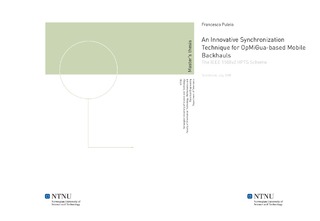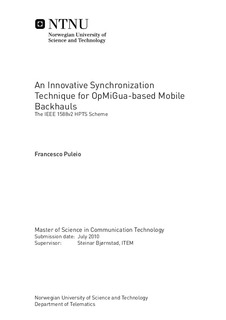| dc.contributor.advisor | Bjørnstad, Steinar | nb_NO |
| dc.contributor.author | Puleio, Francesco | nb_NO |
| dc.date.accessioned | 2014-12-19T14:13:55Z | |
| dc.date.available | 2014-12-19T14:13:55Z | |
| dc.date.created | 2010-10-14 | nb_NO |
| dc.date.issued | 2010 | nb_NO |
| dc.identifier | 356955 | nb_NO |
| dc.identifier | ntnudaim:5669 | nb_NO |
| dc.identifier.uri | http://hdl.handle.net/11250/262342 | |
| dc.description.abstract | Legacy mobile backhauls are based on Time Division Multiplexing. Due to the current evolving of mobile traffic, a major change to a packet-based network is seen as inevitable. This means that the TDM signal cannot be used as source of synchronization anymore. The packet-layer based approach of the IEEE 1588v2 protocol has experienced a successful diffusion, while the physical-layer based solution of Synchronous Ethernet is still under development.A new packet-based synchronization technique is presented along this thesis. It is based on applying the OpMiGua HPTS scheme over a mobile backhaul that is structured into a cluster-type topology. The proposed technique has been given the name of IEEE 1588v2 HPTS scheme. It consists of exchanging timestamps according to the synchronization algorithm standardized into the IEEE 1588v2 protocol but exploiting the switching capabilities of the OpMiGua HPTS node. Differently from the IEEE 1588v2 protocol, our scheme foresees the timestamps to be preprended to the train of time-slots traveling throughout each ring (i.e. the fundamental element of the cluster-type network topology). The presence of time-slots is due to the adoption of the OpMiGua HPTS scheme. Thanks to the hybrid switching capabilities of the OpMiGua HPTS node, it is assured a fixed end-to-end delay to the timestamps. Work done consists of proposing a structure for the OpMiGua HPTS node, allowing to forward and duplicate for processing the timestamps in the same time, and the format of all the messages foreseen into the new scheme. A header format is presented as well as the framing for the messages containing the timestamps. This is applied over the cluster-type topology since the latter is identified as a more suitable physical layer configuration compared to the tree structure of legacy backhauls.The proposed technique is able to improve the accuracy achievable, since the timestamps are made independent from the traffic load into the nodes. Also a saving in terms of bandwidth consumption is provided. | nb_NO |
| dc.language | eng | nb_NO |
| dc.publisher | Institutt for telematikk | nb_NO |
| dc.subject | ntnudaim:5669 | no_NO |
| dc.subject | SIE7 kommunikasjonsteknologi | no_NO |
| dc.subject | Nett og tjenestekvalitet | no_NO |
| dc.title | An Innovative Synchronization Technique for OpMiGua-based Mobile Backhauls: The IEEE 1588v2 HPTS Scheme | nb_NO |
| dc.type | Master thesis | nb_NO |
| dc.source.pagenumber | 110 | nb_NO |
| dc.contributor.department | Norges teknisk-naturvitenskapelige universitet, Fakultet for informasjonsteknologi, matematikk og elektroteknikk, Institutt for telematikk | nb_NO |

